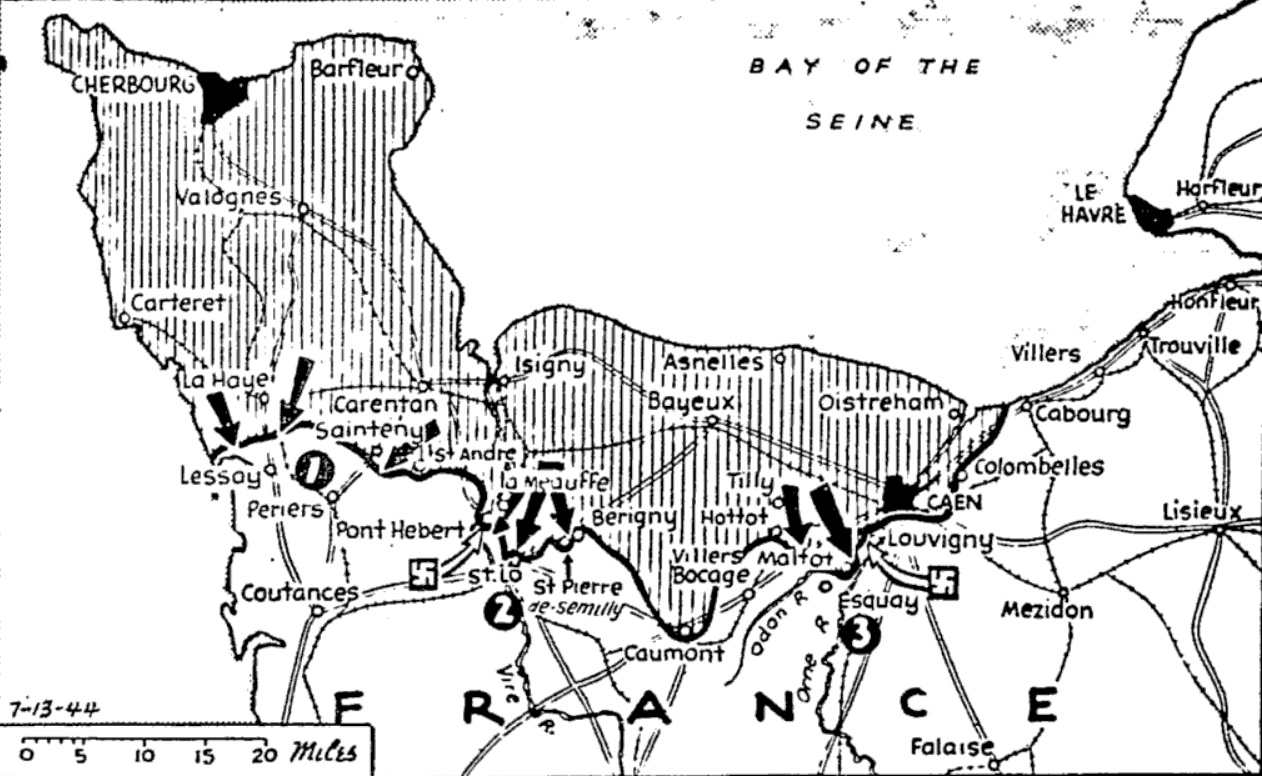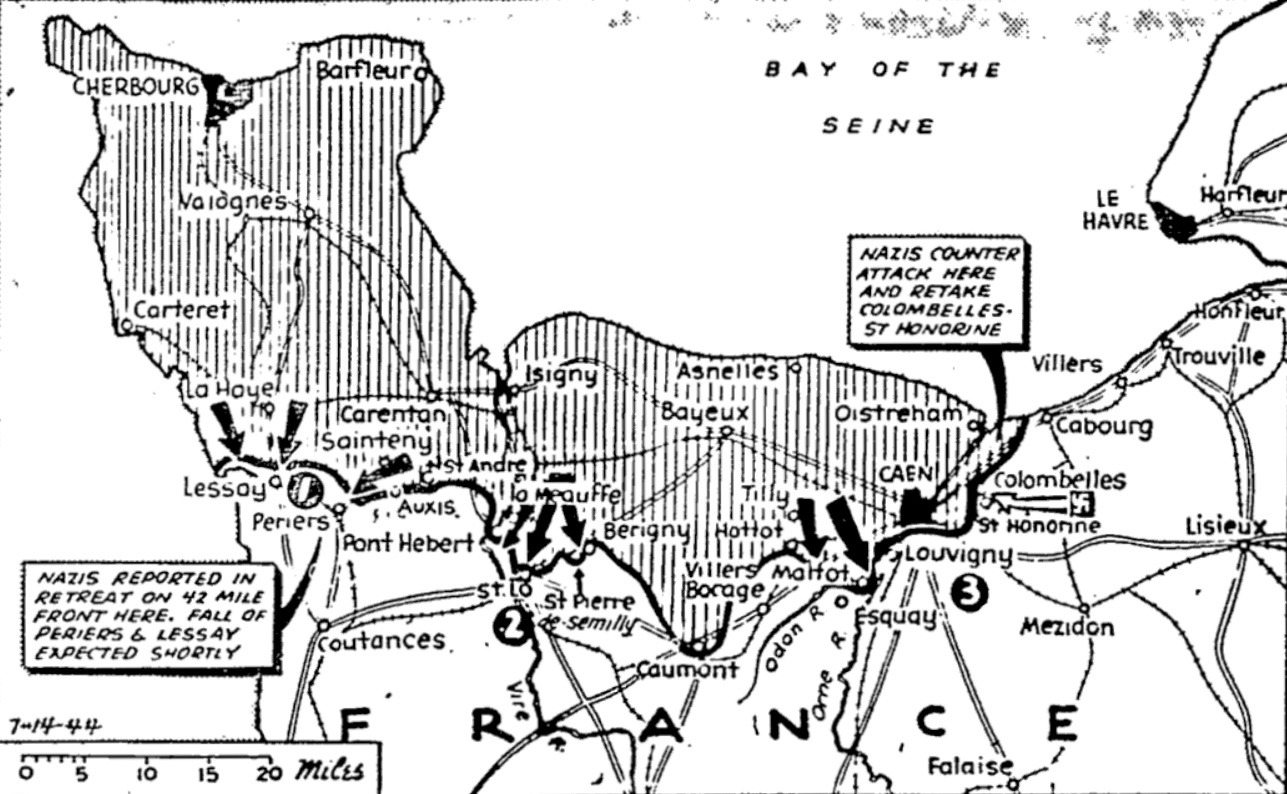Von unserem Lissaboner Berichterstatter
v. m. Lissabon, 13. Juli –
Nachdem auch die beiden Interviews mit Eisenhower über die fliegenden Bomben und die Lage an der normannischen Front pessimistisch ausfielen, machen die Londoner Zeitungen immer größere, vergeblichere Anstrengungen, die Bevölkerung über das anhaltende Feuer von „V1“ zu beruhigen. Sie berichten immer wieder von Angriffen der anglo-amerikanischen Luftwaffe gegen die vermeintlichen Abschußstellen der deutschen Luftwaffe, bei denen sogenannte „Erdbebenbomben“ und ein besonderes. geheimes Zielgerät, welches angeblich den Bombern gestatten soll, Ziele in der Größe einer Briefmarke zu treffen, verwandt werden sollen.
Die „Erdbebenbombe“ und der „Briefmarkentreffer“ sind Englands größte Hoffnung im Kampf gegen „V1.“ Wie wenig sie jedoch in der Lage sind, die über der Insel lastende Bedrohung wirksam zu beseitigen, zeigten drei nacheinander folgende Reportagen des Luftfahrtkorrespondenten der Daily Mail, Colin Bednall, über Angriffsflüge gegen die „Nester“ der fliegenden Bomben. Bednall schrieb diese Berichte als Teilnehmer und Augenzeuge dieser Angriffe. Umso bemerkenswerter ist es, daß er klipp und klar ihre Erfolglosigkeit zugibt und durchblicken läßt, daß eine Einschränkung der „V1“ höchstens durch die Eroberung von ganz Frankreich erzielt werden könnte. Doch selbst das sei unsicher.
Die Londoner Berichte besagen großspurig, daß das Briefmarkentrefferzielgerät schon seit einem Jahr von der anglo-amerikanischen Luftwaffe verwandt werde. Wenn es wirklich die Eigenschaften hat, die ihm die Agitation zuschreibt, dann ergibt sich ein weiterer, schwerwiegender Anklagepunkt gegen den Bombenterror der Engländer und Yankees auf deutsche Städte. Die Luftgangster können sich nicht auf die Streuung der Bomben berufen, können nicht sagen, daß sie Wohnviertel der europäischen Städte „aus Versehen“ getroffen hätten, wenn sie wirklich ein Zielgerät haben und seit Monaten verwenden, welches genaue Punktwirkungen ermöglicht. Drücken sie sich aber vor dieser Selbstanklage, dann geben sie anderseits zu, daß die Bezeichnung „Briefmarkentreffer“ irreführend und damit das Angreifen der vermeintlichen, gutgetarnten Nester der „V1“ ein vergebliches Unterfangen ist, bei dem es nicht gelingen kann, die deutsche Waffe so schnell zum Schweigen zu bringen, wie die englische Bevölkerung es sich wünscht.
Die Schnelligkeit in der Bekämpfung der „V1“ scheint der höchste Wunsch der Inselbewohner zu sein. Im News Chronicle schreibt der bekannte Kommentator Cummings:
Was das Volk von London und Südengland in der Hauptsache festzustellen wünscht, ist, wie lange es dauern wird, bis es gelingt, das Roboterbombardement zum Schweigen zu bringen. Mr. Churchill, der inzwischen zum vorsichtigsten aller Propheten geworden ist, gab keinerlei Garantie, ja nicht einmal Hinweise auf unsere Gegenmaßnahmen.
Cummings vergaß hinzuzufügen, daß weder Churchill noch sein Schwiegersohn Duncan-Sandys (der jetzt Leiter des Bekämpfungsausschusses geworden ist), noch die Luftabwehr und die englisch-amerikanische Generalität, wie die Unterhauserklärung des Premiers, die von ihr gebilligte Evakuierung Londons und der von ihm befohlene Eilbau von Bunkern zeigen, noch keinerlei Vorstellung haben, wie man „V1“ wirksam begegnen könne, und daß gerade deshalb, wie Daily Telegraph zugeben mußte, in englischen Abgeordnetenkreisen die Ansicht weiter vertreten wird, Churchill habe mit seiner Erklärung zwar vielleicht vorübergehend psychologisch, niemals aber physisch die Atmosphäre zu klären vermocht, weil die geflügelten Bomben ununterbrochen weiter auf die Insel hageln.
Unter demselben Eindruck steht die Daily Mail, welche wieder einmal Anlass findet, Churchills Maßnahmen heftig zu kritisieren. In ihrem Leitartikel klagt das konservative Blatt die Regierung an, ihre Evakuierungsorder einseitig abgefasst zu haben. Das konservative Blatt so meint:
Außer den Müttern mit Kindern unter fünf Jahren, gebe es sehr viele Leute, die heimatlos geworden wären, und aus sonstigen guten Gründen, wohl im Zusammenhang mit dem neuen Blitz, London verlassen müßten. Es gebe sehr viele Ehemänner, die ihre kinderlosen Frauen aus der Hauptstadt entfernt zu wissen wünschten. An diese Fälle sei nicht gedacht worden. Inzwischen seien obendrein auch die Gründe für die Absperrung Südenglands hinfällig geworden.
Diese Maßnahme habe zur Überfüllung anderer Gebiete geführt, die wiederum von den Hoteliers, Gastwirten und Quartiergebern benutzt worden wären, und benutzt würden, um horrende Gewinne herauszuschlagen. Der Abgeordnete Sir Herbert Williams habe im Unterhaus die Regierung auf einen besonders krassen Fall aufmerksam gemacht. Ein Mann aus Südengland, der seine Frau und seine Kinder in ein mittleres Hotel des englischen Nordwestens habe einquartieren wollen, hätte darauf verzichten müssen, weil der Hotelier drei Guineas für den Tag und einen Monat Vorauszahlung verlangt habe.
Daily Mail erklärt:
Dieser Skandal des Profitierens an möblierten Zimmern in Hotels und Gasthäusern ist nicht neu. Die Minister müßten dafür verantwortlich gemacht werden, weil sie noch keine Regelung getroffen hätten, die den augenblicklichen Notwendigkeiten entsprächen.
Die Verantwortung fällt auf den Board of Draea, das Gesundheitsministerium, das Sicherheitsministerium und das Ernährungsministerium. Diese versuchen sie aber sich gegenseitig zuzuschieben. Dies wiederum schaut nach Chaos in der Verwaltung aus, und es ist an der Zeit, jemand verantwortlich zu machen und etwas zu unternehmen.
Diese Zustände sind typisch für die geistige Haltung in der britischen Plutokratie. Selbst aus der kriegsbedingten Evakuierung von Frauen und Kindern aus bedrohten Gebieten versteht man auf der Insel Geschäfte zu machen. Mit einer derartigen Moral gehen sie in eine Phase des Krieges hinein, von der die New York Herald Tribune schreibt: „Die zweite Schlacht um London hat begonnen. Sie wird grimmig und blutig sein.“
Der Londoner Korrespondent des gleichen amerikanischen Blattes Barsons befasst sich ausführlich mit „V1“ und schließt sich dem Urteil der englischen Blätter an. Es sei verwunderlich, daß Churchill so lange gewartet habe, um der Welt etwas zu erklären, was die Deutschen sicherlich längst gewusst hätten. Derselbe Berichterstatter schildert die Wirkung der fliegenden Bomben ausführlich und gibt einen Vorfall wieder, der eine sehr deutliche Sprache über die Wucht der „V1“-Hammerschläge redet. Sein Mitarbeiter Josef Gristoll, der für die New York Herald Tribune als Frontberichterstatter in der Normandie eingesetzt gewesen sei, habe sich bei seiner Rückkehr wegen Krankheit bei ihm gemeldet und ihm erklärt: „Bitte, schicken Sie mich nach Frankreich zurück. Meine Frau in Amerika wird entsetzt sein, mich in London zu wissen.“ Demnach ist es heute unter den Nordamerikanern bereits eine ausgemachte Sache, daß es weniger gefährlich ist, an der Front zu stehen als im Zielbereich der „V1.“
Der Berichterstatter schildert weiter eine Szene bei einer Stabsbesprechung englisch-amerikanischer Offiziere. Eine fliegende Bombe heulte herab. Die Offiziere verloren völlig ihre Würde, warfen «ich flach auf den Boden und krochen unter die Schreibtische „Ich habe die vergangenen zwei Jahre und acht Monate in London gelebt,“ erklärte der Berichterstatter, „und bis zum ersten Angriff der fliegenden Bomben auf London habe ich niemals das Gefühl gehabt, in der Nähe des Krieges zu sein und fühlte mich vor den Kollegen an der Front beschämt. Ich kann nicht behaupten, daß ich heute ähnlich denke… Ich gebe zu, daß ich ein wühlendes Gefühl in der Magengegend verspüre, wenn ich eines Dieser Dinger heranbrausen höre. Ich stecke dann gern den Kopf unter ein Kissen. Vielleicht dumm, aber eine Menge Legte retteten auf diese Weise ihre Augen und Ohren.
Im gleichen Ton fährt Mr. Barsons in seinen Schilderungen fort und sieht bisher nur einen positiven Punkt. Er glaubt, daß die fliegenden Bomben zu einer Verbesserung der englisch-amerikanischen Beziehungen beitragen. Um diese kühne Behauptung zu erklären, führt er einen weiteren Vorfall an. In der Nähe einer Arrestanstalt, in welcher die Engländer „Betrunkene und andere schlechte Kerle der US-Armee“ untergebracht hatten, schlug eine „V1“ ein. Diese Männer sind dann sofort entlassen worden, um an den Aufräumungsarbeiten teilzunehmen. Dabei hätten die Engländer ihnen sogar Bier gereicht. Interessant an diesen Beispielen ist, daß darin überwiegend von Einschlägen in der Nähe militärischer Ziele wie Stabsgebäude und Soldatenunterkünfte gesprochen wird. Ein weiterer Beweis dafür, daß „V1“ im Gegensatz zur blinden Bombentechnik der Terrorflieger gegen militärische Punkte eingesetzt wird.
Dennoch besitzt die amerikanische Zeitschrift Philadelphia Inquirer, die zu den Blättern gehört, die am lautesten dem Bombenkrieg gegen deutsche Frauen und Kinder Beifall gezollt haben, die Dreistigkeit zu schreiben:
Der englische Premier hat der Welt das abschreckende Bild der Nazibestie in ihrer wahnsinnigen Orgie wahllosen Schlachtens vermittelt. Die düstere Zukunftsaussicht, die uns die fliegenden Bomben eröffnen und aus der wir entnehmen, daß selbst wir Amerikaner wohl kaum vor einer Auseinandersetzung mit diesem todausteilenden und von einem hasserfüllten Feind abgeschossenen Ungeheuer bewahrt bleiben werden, ist eine Bedrohung, der hauptsächlich bei der Konferenz am Friedenstisch begegnet werden muß.
In ohnmächtiger Wut drohen unsere Feinde mit einem „bösen Frieden,“ obwohl sie die Ausmaße der Gefahr, die in Gestalt der „V1“ über ihnen hängt, zu erkennen beginnen. Sie wollen heute nicht wahrhaben, daß sie die Erfinder der „wahnsinnigen Orgie wahllosen Schlachtens“ und damit die Bestien gewesen sind, die den Krieg gegen die Zivilbevölkerung einleiteten. Vor 14 Tagen meinte der Londoner Daily Sketch, „V1“ sei eine lächerliche Narrenwaffe, heute ruft das gleiche Blatt nach Rache – Immerhin eine bezeichnende Sinnesänderung!

